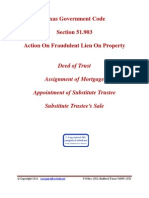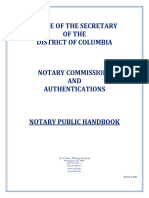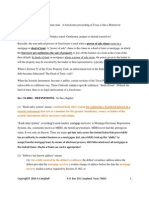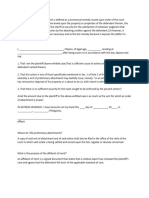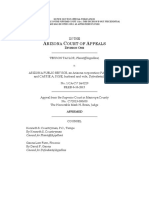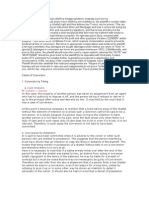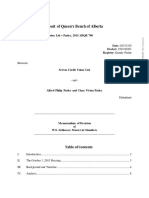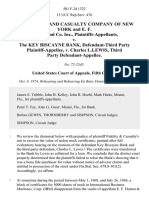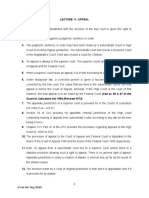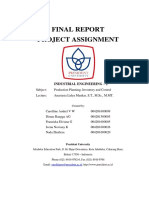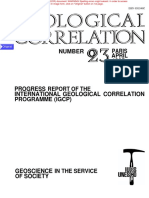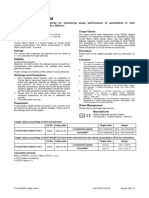Aud - Discharge of Bankrupt
Aud - Discharge of Bankrupt
Uploaded by
Audrey LimCopyright:
Available Formats
Aud - Discharge of Bankrupt
Aud - Discharge of Bankrupt
Uploaded by
Audrey LimCopyright
Available Formats
Share this document
Did you find this document useful?
Is this content inappropriate?
Copyright:
Available Formats
Aud - Discharge of Bankrupt
Aud - Discharge of Bankrupt
Uploaded by
Audrey LimCopyright:
Available Formats
Chapter 6: Discharge of a Bankrupt
1.0 Introduction
A bankruptcy order may be set aside or a bankrupt may be discharged in one of the several ways:
i. upon settlement of all debts;
ii. by application of annulment or rescission of bankruptcy order;
iii. discharge by the court;
iv. discharge by the DGI; or
v. automatic discharge
Vide ss.91 & 92 Insolvency Act 1967 – High Court shall have the jurisdiction to hear all issues
arising out of a bankruptcy order and may review, rescind, or vary any order.
Time for appeal: 14 days from the date of the judgment or order was perfected (extracted of the
signed & sealed order)
Note: Appeal shall not operate as a stay of bankruptcy.
1.1 Annulment
S.105(1) IA 1967 - Power of court to annul bankruptcy order when:
(a) Debtor ought not have been adjudged bankrupt;
(b) Where it is proved to the satisfaction of the court that the debt of the bankrupt are paid in
full; or
(c) Where It appears to the court that proceedings are pending in the Republic of Singapore
for the distribution of the bankrupt’s estate and effects among his creditors under the
bankruptcy or insolvency laws of the Republic and that the distribution ought to take place
in that country.
S.105(2) All acts done by DGI prior to annulment shall be valid.
S.105(3) annulment must be gazette and published in at least one local paper.
Kwong Yik Bank v Haw Chiew Yin [1985] 2 CLJ 31
→ Facts: Judgment was obtained in 1976 for RM30,000/-. Subsequently RM15,000/- was
paid towards the reduction of the judgment debt. By 1981, the outstanding balance with
interest was around RM30,000/-. Applicant issued a bankruptcy notice and RO and AO
was made. Subsequently a further sum of RM6,000/- was paid in full and final settlement.
Respondent filed a motion to annul the RO & AO. HC allowed. Appellant appealed.
→ FC: On the records the bankrupt Respondent had failed to satisfy that the proved debt
had been fully paid. The effect of an annulment is to wipe out the bankruptcy. It would
have been different if the application were for a discharge.
Ng Yen Kok v Amfinance Berhad [2013] 1 LNS 366
→ Bankruptcy notice and creditor’s petition served via substituted service. However, appeal
of record did not contain the order for Substituted Service of the Bankruptcy Notice.
→ Since the RO & AO (now bankruptcy order) were based on invalid creditor’s petition and
bankruptcy notice, the bankruptcy order was annulled and set aside.
© Prepared by Lim Shu Ting (2020)
Soo Kok Leong v HSBC Ltd [2009] 6 CLJ 62
→ Bankruptcy order set aside as there was an error in the sum where the sum owing was far
below the statutory limit. Error was fatal and could not be salvaged by the Act.
Bungsar Hills Holdings S/B v Dr Amir Farid Datuk Ishak
→ Issue: Whether there was sufficient grounds for the court to annul the AO and rescind the
RO when the debtor was in the middle of negotiating settlement and was not aware of the
bankruptcy notice that was served by way of substituted service.
→ COA: Appeal dismissed.
(i) S.105(1) was a discretion and the judge had exercised it correctly. No reason
to meddle with the judgment.
(ii) By annulling the AO on the ground that ‘the debtor has money tied up
somewhere’, might open the floodgate where debtors who neglect to oppose a
petition can later be freed from adjudication by resorting to s 105(1).
(iii) Where the court is satisfied that the debt has been paid in full of the knowledge
of the DGI. All dealings should be made through the DGI.
→ FC: Appeal by the judgment creditor dismissed. Reversed the decision of the CA and
reinstated the decision of the HC in annulling the AO and RO. Exercise of discretionary
power under the first limb of s 105(1).
→ Abdul Hamid b Mohamad, FCJ
(a) the phrase "where in the opinion of the court a debtor ought not to have been
adjudged bankrupt, ..." covers not only purely technical grounds like defective
service of the bankruptcy notice or the creditor's petition but also covers other legal
grounds like an abuse of the process of the court.
(b) While the debtor's "ability to pay his debt" may not be a "technical ground", it is a
"legal ground" which falls within the scope of the said phrase;
(c) In the circumstances of this case, the fact that the debtor did not appear at the
hearing to contest the petition does not disqualify him from applying for the
annulment of the adjudication order pursuant to s 105(1) of the Act;
(d) On the facts of this case, there is no reason for this court to interfere with the
findings of fact of the Learned judge that the respondent was solvent and was able
to pay his debt or with the exercise of his discretion."
Hasnah Che Hassan v Hongkong Bank Malaysia Bhd [2010] 7 CLJ 190
→ BN and CP not served at correct address; Inaccurate calculation of interest in BN; Affidavit
of process server did not state who directed him and his capacity to serve;
→ BN was therefore a nullity, and due to the cumulative defects, the bankruptcy order was
annulled.
Re Subramaniam Palani; ex p Tharenpalan Subramaniam
© Prepared by Lim Shu Ting (2020)
→ The judgment debtor ('Subramaniam' - JD) was a partner in Subrita Enterprise that
appointed the judgment creditor ('Tharenpalan' - JC) to carry out road surfacing works.
→ When Subrita Enterprise failed to pay the JC sued and obtained a Final judgment against
the JD on 25 June 2004 for RM17,500 with interest of 8% per annum from 27 May 1995
till full settlement and costs of RM3,864, a bankruptcy notice was issued on 5 December
2011 against the JD for RM42,498.24. Mention before the SAR was fixed on 21 March
2012.
→ JC being unable to effect personal service on the JD obtained an order for substituted
service on 3 May 2012.
→ Subsequently, JC filed a creditor's petition on 2 January 2013 and again obtained an order
for substituted service on 10 January 2013.
→ At the hearing of the creditor's petition on 26 February 2013, the SAR struck off the
bankruptcy proceedings because the creditor's petition was filed out of time without leave
for an extension of time to file the creditor's petition.
→ JC appealed successfully to judge-in-chambers on 27 June 2013.
→ The creditor's petition was again heard before the SAR on 18 July 2013 and a RO & AO
granted.
→ JD upon learning from a third party applied under s. 105(1) of the Bankruptcy Act 1967 to
annul the RO AO. During the appeal, the JD submitted that:
o the bankruptcy process was irregular in that the creditors' petition was filed out of
time without leave or prior obtaining an extension of time and that he had not been
properly served and made aware of the bankruptcy proceedings.
o the court order for substituted service did not stipulate for a newspaper
advertisement of the bankruptcy notice and creditor's petition.
o computation of the amount due under the final judgment in the bankruptcy notice
was wrong by reason that it included pre-judgment interest that was already time-
barred by the Limitation Act 1953. If this interest was removed, the judgment debt
fell below the RM30,000 as provided in s. 5(1) of the BA
o the date stated and used for the computation of the pre-judgment interest in the
bankruptcy notice was wrong, i.e. two days earlier than that stated in the judgment.
→ Therefore, the ROAO was void.
→ HC Held:
o allowing appeal with costs; setting aside order of senior assistant registrar
o Even if the filing of the creditor's petition was out of time, no particulars in this
regard were given in JD’s supporting affidavit. In any event, even if this was so, it
did not ipso facto invalidate the ROAO obtained if there was non-compliance with
the Bankruptcy Act or Rules. Further, this point was already earlier dealt on appeal
by JC to the judge-in-chambers after the creditor's petition was struck off by the
SAR. Therefore, the court was functus officio on this point.
o Although r. 97 and 109 BR 1969 prescribe personal service of the bankruptcy
notice and creditor's petition, r. 110 also provide for substituted service if the court
is satisfied that prompt personal service could not be effected and the bankruptcy
notice and/or the creditor's petition is deemed to have been duly served if the
judgment creditor complied with the court order granting substituted service. The
mode and manner of substituted service are not prescribed in the Bankruptcy
Rules, thus by virtue of r. 276 , O. 62 r. 5 ROC 2012 would apply mutatis mutandis.
© Prepared by Lim Shu Ting (2020)
o Although JC had complied with the substituted service order of the court, the
hearing of the creditor's petition against JD was conducted ex parte. Thus, by the
invocation and application of O. 32 r. 6 of the ROC mutatis mutandis, the ROAO
may be set aside. This is because it is not a definitive order but only a provisional
order that could be subjected to review based on evidence and arguments
subsequently adduced by the opposing party. There was no prohibition or
impediment against the review being undertaken pursuant to s. 105(1) of the BA
application rather than a setting aside application that is normally done.
o The merger principle did not automatically apply to all pre-judgment interest. The
principle is invoked only if the interest was contractually agreed by the parties with
the merger provision built in the contract. It did not, however, apply if pre-judgment
interest is awarded pursuant to s. 11 of the Civil Law Act 1956 as is the case herein.
Thus, JC had over computed the interest and the legally due sum as demanded
against JD in the bankruptcy notice was excessive. The time barred pre-judgment
interest must be discarded. It followed that the ROAO granted was void because
it was less than the statutory threshold of RM30,000/-
o Since bankruptcy proceedings result in personal inconvenience as well as grave
financial and reputational consequences, the court must require the JC to be
vigilant and diligent in ensuring that due process had been strictly followed.
o The misstatement of the date herein was fatal because it misrepresented the
underlining originating basis of the bankruptcy proceedings. It was thus more than
a formal defect. The availability of s. 131 of the Bankruptcy Act and r. 274 of the
Rules respectively should be sparingly resorted to.
Note: If judgment is more than six years, leave of court must be obtained before commencing
bankruptcy proceedings. No longer following Perwira Affin Bank Bhd v Lim Ah Hee.
Cases:
Dr. Shamsul Bahar Abdul Kadir & Another Appeal v RHB Bank
Am Fraser Securities Pte Ltd v Poh Gaik Lye
Re Chan Chao Keong ; Ex parte Ambank (M) Bhd
1.2 Discharge by Court
1. Where applying to court for a discharge the bankrupt has to produce to the Registrar a
certificate from the DGI specifying the number of creditors of whom he has notice and
whether they have filed a proof of debt.
2. S.33(1) – Court shall appoint a day for the hearing of the application
i. r.183 – Registrar shall give DGI 28 days notice of the date, time and place
of the hearing which shall be gazette. DGI shall give 14 days notice of the
hearing to each creditor.
3. S. 33(2) – if a creditor should wish to oppose the hearing of the application, he has to give
notice to the DGI stating his grounds based on the bankrupt’s conduct
4. s.33(4) – The court has to consider various factors in determining the application for
discharge:
a. whether the bankrupt has committed any offence
© Prepared by Lim Shu Ting (2020)
b. age of the bankrupt
c. bankrupt’s conduct
d. extent of the debt that has been settled
e. public interest
f. DGI’s report
5. Court may refuse, suspend, or grant a conditional discharge.
6. S.33(5) – if after 2 years of such Order, the court is satisfied that the bankrupt cannot fulfill
such order it may vary the order.
Mohana Sundari d/o E Subramaniam ex p United Prime Corporation
→ Facts: An appeal by the bankrupt on the conditions imposed by the SAR for discharge.
Court considered the facts of the case whereby bankruptcy arose as a result of a
guarantee which she signed at the age of 25 years. Furthermore:
o Bankruptcy arose through no fault of hers
o She was not in control of the affairs of the company in which her siblings were
directors
o The period of the bankruptcy
o Her contribution to the benefit of the creditors
o The magnitude of the deficiency in the bankruptcy estate
o Value of the bankrupts total assets against the value of the total liability
o Bankrupt’s domestic, social and financial circumstances
o The number of creditors and their objections
→ HC ordered her to be discharged as a bankrupt subject to only 1 condition
Re Ah Kang
→ Facts: Application was made 3 years after being adjudged a bankrupt. Debts due had
been settled by a third party. Only one debt was outstanding where according to OA’s
Report creditor would be paid a dividend of 4.04%. Creditor objected but court noted that:
o the principal debt had been settled and what remained was only the interest
o bankrupt was 60 years old
o had been faithfully paying RM60/- to the OA every month
o not likely to be gainfully employed
→ HC granted the discharge with one condition.
Asia Commercial Finance (M) Bhd v Bassanio Teo Yang
→ Facts: Respondent had executed a guarantee for a hire purchase for a car. Principal had
defaulted. As respondent had been unable to pay as he was adjudged a bankrupt.
Respondent agreed with OA to pay RM50/- a month. Appellant now objects to the DGI
discharging the respondent under s. 33A.
→ HC:
© Prepared by Lim Shu Ting (2020)
(i) Discharge granted. Fact that DGI did not file a financial report not adverse to
respondent. Respondent was a ‘social guarantor ‘and was not reckless or
contribute to the bankruptcy.
(ii) The power of the court to prohibit the DGI from issuing the certificate to discharge
the respondent for a period of two years should only be exercised in clear cut
cases of abuse of s. 33A. Clear cut cases of abuse would be where the bankrupt
had obtained huge loans with no intention of paying them back or where the
bankrupt was maintaining an extravagant lifestyle beyond his reported income or
where he had continued to be reckless in his financial affairs. From the affidavit
of the representative of the DGI, there was no reason to infer that there had been
any abuse of s. 33A.
Lim Tee Keong v HLG Securities Sdn Bhd
→ Facts: This was an appeal by appellant (bankrupt) against the dismissal of his application
to be discharged from his bankruptcy by the High Court. The application for the discharge
was made pursuant to s. 33 BA1967. The bankrupt, had been in bankruptcy for ten years
before the application for discharge, was ill, and passed away. The appellant continued
the appeal in the bankrupt’s place. The appellant contended that:
(i) the bankrupt was of advanced old age and was suffering from critical illness
(ii) The judge under s. 33 of the Act had failed to address his mind to two critical
facts, i.e. (a) bankrupt was adjudged a bankrupt due to losses suffered on the
share market; and (b) the bankrupt had suffered the losses during the Asian
Financial Crisis 1997/1998. Therefore, the bankrupt had become 'insolvent not
through any fault, moral or otherwise, but through just being caught at the wrong
turning of the economic cycle'
(iii) There was no evidence to suggest that the bankrupt had used 'dishonest or
fraudulent methods in conducting his business affairs to the detriment of their
creditors' or that the bankrupt had supported a lifestyle of 'rash and extravagant
living'.
(iv) the judge had erred to hold that the bankrupt had committed an offence
under s.16(2)(b) of the Act when he failed to file his statement of affairs within 21
days.
→ In opposing the appeal, the creditor submitted that the discharge should not be allowed
because the Director General of Insolvency's ('DGI') report was incomplete and had failed
to show that the DGI had undertaken a comprehensive and thorough investigation on the
assets of the bankrupt.
→ Held, dismissing appeal with costs:
(i) The court’s discretion under s. 33(3) of the Act is wide subject to the consideration of
equity, fairness and good conscience' and that a bankrupt should not be put under
bondage for his entirety. The court must consider the DGI’s report on the bankrupt's
conduct and affairs.
(ii) In managing a debt of about RM150 million, the DGI's report was very brief. The DGI did
not report on assets which the bankrupt owned in his name, within five years before the
date of the RO. The DGI should have also investigated all the properties previously
owned by the bankrupt and the current owners of the property if any to determine whether
the current owners had a close relationship with the bankrupt and whether there was
© Prepared by Lim Shu Ting (2020)
evidence that the current owners were holding the properties as nominees for the
bankrupt'.
(iii) The trial judge had ordered that the bankrupt pay 55% dividend for failing to file his
statement of affairs within 21 days after the RO as required under s. 16(3). The
requirement under the section is mandatory and therefore non-compliance would mean
breach of statutory provision. The trial judge was thus correct to equate it with an offence
punishable as a contempt of court.
1.3 Discharge under Certificate by the DGI
s.33A(1)-(6) - DGI has to serve Notice of Intention to Discharge the bankrupt on each creditor
who has filed a proof of debt, there should be a minimum lapse of 5 years from the date of issue
bankruptcy order.
s.33B(2) - within 21 days a creditor has to serve his Notice of Objection stating his grounds. A
failure to do so would be deemed as there being no objections.
s.33B(3) - A creditor whose notice of objection has been rejected by the DGI can appeal to the
HC
s.33B(4) court may dismiss the application or order that DGI shall not issue a certificate for a
period not exceeding 2 years.
Re Benny Ong Wee Siang, ex p UOB (M) Bhd
→ Discretion of the DGI to discharge based on a certificate of automatic discharge must be
exercised reasonably considering the public interest and justice.
Maybank Finance Bhd v Lee Kee Sen
→ The burden is on the DGI to prove reasonableness of the discharge.
1.4 Automatic Discharge
S. 33C IA 1967
(1) A bankrupt shall be discharged from bankruptcy under this section on the expiration of
three years from the date of the submission of the statement of affairs under subsection
16(1)—
(a) if the bankrupt has achieved amount of target contribution of his provable debt;
and
(b) if the bankrupt has complied with the requirement to render an account of moneys
and property to the Director General of Insolvency under paragraph 38(1)(b).
(2) Contribution of the bankrupt’s provable debt referred to in paragraph(1)(a) shall be
determined by the Director General of Insolvency and the Director General of Insolvency
shall take into account—
(a) the provable debt of the bankrupt;
(b) the current monthly income of the bankrupt;
(c) the extent to which the current monthly income of the bankrupt’s spouse may
contribute to the maintenance of the bankrupt’s family;
(d) the monthly income that the bankrupt may reasonably be expected to earn over
the duration of the bankruptcy, taking into account—
© Prepared by Lim Shu Ting (2020)
i. the previous and current monthly income of the bankrupt;
ii. the educational and vocational qualifications, age and work experience of
the bankrupt;
iii. the range of monthly income earned by persons who are employed in
occupations, positions or roles similar to that in which the bankrupt is, or
can be expected to be, employed;
iv. the effect which the bankruptcy may have on the bankrupt’s earning
capacity or other income;
v. the prevailing economic conditions; and
vi. the period of time during which the bankrupt is likely to be capable of
earning a meaningful income;
(e) the reasonable expenses for the maintenance of the bankrupt and the bankrupt’s
family; or
(f) the property of the bankrupt under paragraph 48(1)(b) which may be realized
during the period of three years.
(3) For the purposes of a discharge under this section, the Director General of Insolvency
shall serve a notice of the discharge to each of his creditors not less than six months
before the expiration of the period referred to in subsection (1), but such notice shall not
be served earlier than a year before the expiration of such period.
(4) A creditor who wishes to object to the discharge under this section shall, within twenty-
one days from the date the notice in subsection (3) is served on him, make an application
as prescribed to the court for an order to suspend the discharge under this section, but no
objection shall be made except on the following grounds:
(a) that the bankrupt has committed any offence under this Act or under section 421,
422, 423 or 424 of the Penal Code;
(b) that the discharge under this section would prejudice the administration of the
bankrupt’s estate; or
(c) that the bankrupt has failed to co-operate in the administration of estate.
(5) A creditor who fails to file an application in accordance with subsection (4) is deemed to
have no objection to the discharge.
(6) A notice of application under subsection (4) shall be served on the Director General of
Insolvency and the bankrupt at least fourteen days before the date of hearing of the
application and the court shall hear the Director General of Insolvency and the bankrupt
before making an order on the application.
(7) Upon an application made under subsection (4), the court may, if it thinks just and
expedient—
(a) dismiss the application and approve the discharge under this section; or
(b) suspend the discharge under this section for a period of two years.
(8) Where the court makes an order under paragraph (7)(b), the bankrupt shall—
(a) continue to fulfil his duties and obligations under this Act during that period; and
(b) be discharged automatically at the end of the two years’ period.
(9) The Director General of Insolvency shall, upon the application of any interested person
and payment of the prescribed fee, issue a certificate of automatic discharge to the
applicant—
(a) upon the making of an order under paragraph(7)(a); or
(b) where there is no objection under subsection (4), on the expiration of the period
referred to in paragraph(1)(a).
© Prepared by Lim Shu Ting (2020)
1.5 Effect of Discharge
1. S.35 Subject to the conditions imposed on the bankrupt, a discharge shall release a
bankrupt from all debts.
2. However, ss.35(1)-(5) states that a discharge shall not operate to release a bankrupt from
any debts due to the government or any branch office of public revenue; or due to any
person under any offence, fines; or fraud or fraudulent breach of trust.
3. A discharge shall not release any partner or co-trustee of the bankrupt from liability.
1.6 Reciprocal Arrangements – Singapore and Other Countries
S.104 - reciprocal recognition and arrangement relating to Singapore and designated countries –
Singapore, Brunei, UK, Hong Kong, New Zealand, Sri Lanka, India.
1. Effect is that the property of the bankrupt in these designated countries will vest in the
respective DGI who will deal with the property and send the proceeds to the DGI Malaysia
less administrative expenses.
2. Where property overseas is charged or otherwise encumbered the creditor will be a
secured creditor.
3. Where there is no reciprocal agreement the DGI can direct the bankrupt to execute a PA
in favour of a named DGI – usually an embassy official of that country. Bankrupt will have
to execute a MOT in accordance with the laws of that country and send the documents to
the official at the Embassy.
© Prepared by Lim Shu Ting (2020)
You might also like
- Ricoh mpc307 407 Service ManualDocument1,001 pagesRicoh mpc307 407 Service Manualmark adams100% (3)
- California Commercial CodeDocument1 pageCalifornia Commercial Codeeric schmidtNo ratings yet
- Construction Liens for the Pacific Northwest Alaska Idaho Oregon Washington Federal Public Works: A PrimerFrom EverandConstruction Liens for the Pacific Northwest Alaska Idaho Oregon Washington Federal Public Works: A PrimerNo ratings yet
- Teacher Tenure ActDocument32 pagesTeacher Tenure ActleighNo ratings yet
- Claim Form TwitterDocument14 pagesClaim Form Twitterjeff_roberts88167% (3)
- Flowchart Bankruptcy Proceedings Up To The Stage A Debtor Is Adjudged A BankruptDocument2 pagesFlowchart Bankruptcy Proceedings Up To The Stage A Debtor Is Adjudged A BankruptAudrey LimNo ratings yet
- Socio Economic QuestionnaireDocument9 pagesSocio Economic QuestionnaireTOt's VinNo ratings yet
- Together Digital Agency Credentials 11-17 PDFDocument20 pagesTogether Digital Agency Credentials 11-17 PDFAnonymous nFFkqRNo ratings yet
- Our Health Ourselves - Uganda LTD Mem - Articles of Association - FinalDocument86 pagesOur Health Ourselves - Uganda LTD Mem - Articles of Association - Finalagula joseph ogororNo ratings yet
- Texas 51.903 Lien R1Document5 pagesTexas 51.903 Lien R1j mcguireNo ratings yet
- Tax Form Classification IRS Manuel 6209 Sec 4 Doc Types 2023Document32 pagesTax Form Classification IRS Manuel 6209 Sec 4 Doc Types 2023DudeNo ratings yet
- Public Incidental / Affidavit of Facts Delivery To The Judicial Council of California / Commission On Judicial PerformanceDocument66 pagesPublic Incidental / Affidavit of Facts Delivery To The Judicial Council of California / Commission On Judicial PerformanceAsim BeyNo ratings yet
- Taxing Times For Distressed HousingDocument2 pagesTaxing Times For Distressed HousingQuerpNo ratings yet
- IMCh 02Document13 pagesIMCh 02Sakub Amin Sick'L'No ratings yet
- Work 1Document216 pagesWork 1BipinNo ratings yet
- Durable POADocument5 pagesDurable POAchedderquestNo ratings yet
- Notary Public Handbook 8-2019Document27 pagesNotary Public Handbook 8-2019seriously funny jokesNo ratings yet
- OCC Guidance On Unfair or Deceptive Acts or Practices Advisory-Letter-2002-3Document8 pagesOCC Guidance On Unfair or Deceptive Acts or Practices Advisory-Letter-2002-3Charlton Butler100% (2)
- Instructions For Form 990-T: Pager/SgmlDocument20 pagesInstructions For Form 990-T: Pager/SgmlIRSNo ratings yet
- How To Request Pooling and Servicing Agreement A Step-By-Step Guide - Pool Tips USADocument15 pagesHow To Request Pooling and Servicing Agreement A Step-By-Step Guide - Pool Tips USAStephen Monaghan100% (1)
- Fair Lending Notice PDFDocument2 pagesFair Lending Notice PDFJesse100% (2)
- Foreign Exchange BASIC INFODocument27 pagesForeign Exchange BASIC INFOasifmahmud20diu100% (1)
- W 4 Qualifying Declaration 053010Document3 pagesW 4 Qualifying Declaration 053010Ted WacholtzNo ratings yet
- Global Mail Limited v. US Postal Service, 4th Cir. (1998)Document15 pagesGlobal Mail Limited v. US Postal Service, 4th Cir. (1998)Scribd Government DocsNo ratings yet
- Mary Ann Kelly v. Railroad Retirement Board, 625 F.2d 486, 3rd Cir. (1980)Document14 pagesMary Ann Kelly v. Railroad Retirement Board, 625 F.2d 486, 3rd Cir. (1980)Scribd Government Docs100% (1)
- 2014-10-08 - Wallace - Educational Package ExhibitsDocument42 pages2014-10-08 - Wallace - Educational Package Exhibitsapi-339692598100% (1)
- Trusts Uses and Considerations Agec 771Document4 pagesTrusts Uses and Considerations Agec 771noelineatugonza59No ratings yet
- Notary Handbook 2024 030824Document31 pagesNotary Handbook 2024 030824Jack WyattNo ratings yet
- Sec. 51.0001. DEFINITIONS. in This Chapter:: Qui Tam Suits Across The United States That Prove MERSDocument8 pagesSec. 51.0001. DEFINITIONS. in This Chapter:: Qui Tam Suits Across The United States That Prove MERSCaliforniag100% (1)
- Table of Contents - Chapter 12: Accounts ReceivableDocument43 pagesTable of Contents - Chapter 12: Accounts Receivabletgbyhn111No ratings yet
- Land of The PeopleDocument579 pagesLand of The PeopleNetjer Lexx TVNo ratings yet
- US Internal Revenue Service: I1040sse - 1998Document4 pagesUS Internal Revenue Service: I1040sse - 1998IRSNo ratings yet
- AFFIDAVITDocument14 pagesAFFIDAVITLeorebelle Racelis100% (1)
- Taylor v. Aps, Ariz. Ct. App. (2015)Document8 pagesTaylor v. Aps, Ariz. Ct. App. (2015)Scribd Government Docs100% (1)
- Flu Medical ExemptionDocument1 pageFlu Medical Exemptionplayboi501No ratings yet
- Department of The Treasury Internal Revenue Service Notice 1382Document30 pagesDepartment of The Treasury Internal Revenue Service Notice 1382peterjohannes100% (1)
- ROWLAND Et Al v. OCWEN LOAN SERVICING, LLC. Et Al Notice of RemovalDocument6 pagesROWLAND Et Al v. OCWEN LOAN SERVICING, LLC. Et Al Notice of RemovalACELitigationWatchNo ratings yet
- Securities and Exchange Commission: Vol. 80 Tuesday, No. 31 February 17, 2015Document26 pagesSecurities and Exchange Commission: Vol. 80 Tuesday, No. 31 February 17, 2015MarketsWikiNo ratings yet
- Case Study-Remedies For Breach of ContractDocument6 pagesCase Study-Remedies For Breach of ContractBishnu Dhamala0% (1)
- Federal Banking LawDocument46 pagesFederal Banking Lawkirangitam7454No ratings yet
- NON UCC Declaration Ofindependence (1776)Document3 pagesNON UCC Declaration Ofindependence (1776)steedzacharyNo ratings yet
- Florida Exemptions BankruptcyDocument1 pageFlorida Exemptions Bankruptcycottchen6605No ratings yet
- Orange InstructionsDocument1 pageOrange InstructionsJacob FredericksenNo ratings yet
- Chapter 8: Hold or Fold - BankruptcyDocument28 pagesChapter 8: Hold or Fold - BankruptcyJafari SelemaniNo ratings yet
- Marjon A. Limot October 7, 2020 Bsba-3B TTH (5:30Pm-7:00Pm) Fm130:Monetary Policy and Banking Prof: Maam Erlinda J. Diasemen Assignment No.2Document2 pagesMarjon A. Limot October 7, 2020 Bsba-3B TTH (5:30Pm-7:00Pm) Fm130:Monetary Policy and Banking Prof: Maam Erlinda J. Diasemen Assignment No.2MarjonNo ratings yet
- Law AssignmentDocument7 pagesLaw AssignmentBatrisyia Mazlan100% (1)
- Florida's Legal MafiaDocument10 pagesFlorida's Legal MafiaDavid Arthur Walters100% (1)
- AlaAL ZAALIG2011Document5 pagesAlaAL ZAALIG2011Ala Alzaalig100% (1)
- United States Bankruptcy CourtDocument3 pagesUnited States Bankruptcy CourtChapter 11 Dockets100% (1)
- Conversion As An Affirmative Defense To Mortgage ObligationDocument5 pagesConversion As An Affirmative Defense To Mortgage ObligationArlin J. WallaceNo ratings yet
- Primer On TrustsDocument15 pagesPrimer On TrustsAnkur LakhaniNo ratings yet
- ADS Chapter 625 Accounts Receivable and Debt CollectionDocument48 pagesADS Chapter 625 Accounts Receivable and Debt CollectionShabbir BukhariNo ratings yet
- Massachusetts Rules and Orders of The Supreme Judicial CourtDocument332 pagesMassachusetts Rules and Orders of The Supreme Judicial CourtJeffrey UlatanNo ratings yet
- ATF Adverse Action and DisciplineDocument46 pagesATF Adverse Action and DisciplinedcodreaNo ratings yet
- Servus Credit Union LTD V Parlee, 2015Document33 pagesServus Credit Union LTD V Parlee, 2015ravenmailmeNo ratings yet
- Actions To Quiet Title in PennsylvaniaDocument4 pagesActions To Quiet Title in PennsylvaniaJohnny LolNo ratings yet
- Foia HandbookDocument26 pagesFoia HandbookAndrea BeharryNo ratings yet
- United States Court of Appeals, Fifth CircuitDocument8 pagesUnited States Court of Appeals, Fifth CircuitScribd Government DocsNo ratings yet
- Local Rules v12 - Revised 7-1-16Document99 pagesLocal Rules v12 - Revised 7-1-16David BriggsNo ratings yet
- 617 NP BookletDocument77 pages617 NP BookletDexie Cabañelez ManahanNo ratings yet
- Not To Be Published in The Official ReportsDocument7 pagesNot To Be Published in The Official ReportsNora100% (1)
- Chapter - 20 To 25 PDFDocument113 pagesChapter - 20 To 25 PDFRupinder kaurNo ratings yet
- Polk County Circuit Court Clerk ReportDocument11 pagesPolk County Circuit Court Clerk ReportDan LehrNo ratings yet
- Aud (Revised Kye's) - Voluntary Settlement or Scheme of Arrangement PDFDocument2 pagesAud (Revised Kye's) - Voluntary Settlement or Scheme of Arrangement PDFAudrey LimNo ratings yet
- Revisionary Power of High CourtDocument9 pagesRevisionary Power of High CourtAudrey LimNo ratings yet
- Court of Judicature Act 1964 (Revised-1972)Document19 pagesCourt of Judicature Act 1964 (Revised-1972)Audrey LimNo ratings yet
- Addition To Appeal NotesDocument3 pagesAddition To Appeal NotesAudrey LimNo ratings yet
- Chapter 2 Striking Out Pleadings and EndorsementDocument6 pagesChapter 2 Striking Out Pleadings and EndorsementAudrey LimNo ratings yet
- Chapter 11 Enforcement of JudgmentDocument8 pagesChapter 11 Enforcement of JudgmentAudrey LimNo ratings yet
- Biology Form 4 Chapter 9.1Document47 pagesBiology Form 4 Chapter 9.1Audrey LimNo ratings yet
- Chapter 3 Amendment To PleadingsDocument10 pagesChapter 3 Amendment To PleadingsAudrey Lim0% (1)
- The Openuniversity of Sri Lanka: Department of Civil Engineering Bachelor of Technology (Civil) - Level 6Document4 pagesThe Openuniversity of Sri Lanka: Department of Civil Engineering Bachelor of Technology (Civil) - Level 6kz_kamranNo ratings yet
- Final Report Project Assignment: Industrial Engineering - 2Document434 pagesFinal Report Project Assignment: Industrial Engineering - 2Nada0% (1)
- Financial Reporting and Analysis: Project: Glaxosmithkline Pharma Limited Vs Sanofi India LTD (Formerly Aventis Pharma)Document13 pagesFinancial Reporting and Analysis: Project: Glaxosmithkline Pharma Limited Vs Sanofi India LTD (Formerly Aventis Pharma)Krishnesh LunganiNo ratings yet
- TutorialWeek04 SolutionsDocument6 pagesTutorialWeek04 Solutions江世通No ratings yet
- 6.2. Islamic Medicine (Only Slide 6)Document32 pages6.2. Islamic Medicine (Only Slide 6)Roby SandeiaNo ratings yet
- eDocument114 pagesePercy Cusihuaman TorresNo ratings yet
- Megeer Earth TesterDocument2 pagesMegeer Earth TesterWael NashaatNo ratings yet
- PI e TL - HBA1C - L1 34204 2404 13Document1 pagePI e TL - HBA1C - L1 34204 2404 13Osama Ben DawNo ratings yet
- Painted Poetry Colour in Baudelaires Art Criticism Modern French IdentitiesDocument264 pagesPainted Poetry Colour in Baudelaires Art Criticism Modern French Identitiesjohanna_341529511No ratings yet
- TUBEX TF Technical LeafletDocument2 pagesTUBEX TF Technical LeafletFARLIANNo ratings yet
- The Nighe Train & Reunion NotesDocument13 pagesThe Nighe Train & Reunion NotesKalpana KrishnamurthyNo ratings yet
- Draft PCR Word DocumentDocument10 pagesDraft PCR Word DocumentGowthamiGowdaNo ratings yet
- Building 101 - RFIsDocument4 pagesBuilding 101 - RFIspeters sillieNo ratings yet
- PE108Document3 pagesPE108rquintero22-2585No ratings yet
- Unit Lesson Plan Skewer and Marshmallow TowerDocument4 pagesUnit Lesson Plan Skewer and Marshmallow Towerapi-666655399No ratings yet
- Manual: Original InstructionsDocument82 pagesManual: Original InstructionsSouhailee raihanounee100% (1)
- Program Template 1st Water Service Coop SummitDocument3 pagesProgram Template 1st Water Service Coop Summitandrew carranzaNo ratings yet
- The Postcolonial Gramsci 2011Document267 pagesThe Postcolonial Gramsci 2011Mamuka Mgaloblishvili100% (1)
- HKD-100D PA ManualDocument5 pagesHKD-100D PA ManualLucas BarriosNo ratings yet
- Descriptive TextDocument17 pagesDescriptive Textamalia susantiNo ratings yet
- MM Solved PaperDocument10 pagesMM Solved PaperAtika SaleemNo ratings yet
- English PizzeriaDocument2 pagesEnglish PizzeriaKostiantyn CheshykhinNo ratings yet
- Intellectual Property - 1 - Kho Vs CADocument2 pagesIntellectual Property - 1 - Kho Vs CAmereeNo ratings yet
- Failures of Gabion Walls: Ganesh C. Chikute, Ishwar P. SonarDocument7 pagesFailures of Gabion Walls: Ganesh C. Chikute, Ishwar P. SonarnavigareeNo ratings yet
- 2014 Fork Owners ManualDocument73 pages2014 Fork Owners ManualYaksá HiperbólicoNo ratings yet
- Prometric India Contact NumberDocument4 pagesPrometric India Contact NumberWANNA WOHNo ratings yet










